Q&A with UT's Renaissance Man
Ronald L. Vaughn breathed life into a languishing university. Now, after nearly 30 years as president, he leaves it thriving. We talked to him about what worked, what it took and what’s ahead for him after a career that established UT as a pillar of reinvention and innovation.
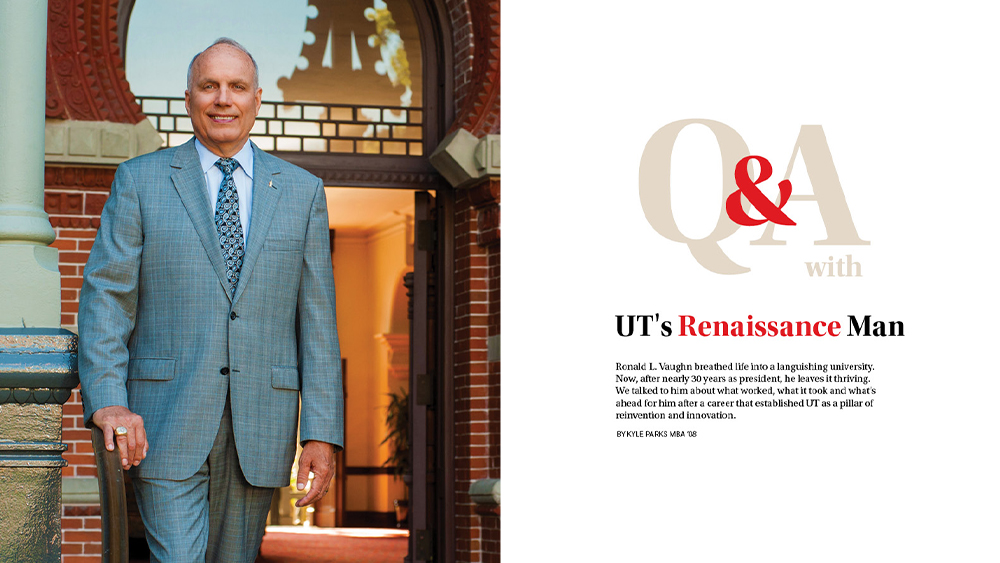 President Ronald L. Vaughn. Photo by Alex McNight
President Ronald L. Vaughn. Photo by Alex McNight
By Kyle Parks MBA ’08
It’s been a remarkable 29½ years. When Ronald L. Vaughn took over as The University of Tampa’s president in January 1995, the school was in deep trouble. UT’s full-time undergraduate enrollment had declined for several years and numbered only 1,420 students. There had been staff and faculty layoffs, as well as salary freezes and benefit reductions. Some of Vaughn’s friends tried to talk him out of taking the job, as they felt the situation was too far gone.
Now, nearly three decades later, enrollment exceeds 11,000. The University’s annual operating revenue has increased from $28 million to an estimated $420 million. And UT has over 200 areas of study on a campus that has been transformed by more than 70 building projects.
Vaughn, the man behind UT’s renaissance, grew up in tiny Paris, Illinois, population just over 8,000 in 1950.
He learned the values of hard work and resiliency from his parents. Vaughn’s father lost his legs at the age of 16 in a railroad accident and later started a business that sold artificial limbs.
Vaughn often held as many as three jobs at a time to pay for his college education — work that ranged from running an A&W stand to lifeguarding at a lake, doing painting jobs for the Illinois Department of Transportation and selling Sarah Coventry jewelry.
After he earned a bachelor’s degree in marketing and a master’s in business administration from Indiana State University, Vaughn earned a doctoral degree in marketing at the University of Georgia. Then, when he was teaching at Bradley University in Peoria, Illinois, and running a thriving marketing research consulting firm, he saw an ad for a faculty position at UT.
He was attracted to the position (and Tampa’s weather), so he answered the ad and was named professor of the Max H. Hollingsworth Chair of American Enterprise in UT’s business school in 1984, where he was asked to create a new marketing major and serve as its department chair. By the late ’80s, Vaughn had established a successful marketing program. He later became director of the MBA program and then dean of the College of Business.
Then, in late 1994, Vaughn was asked to consider becoming the University’s 10th president. When Vaughn retires in May, his tenure will have been one of the longest in the nation: Current university presidents around the U.S. have been on the job an average of only 5.9 years, according to a 2023 survey by the American Council on Education.
Vaughn looks back at his tenure with pride, and he is confident about the University’s future as one of the nation’s highly regarded private universities.
As he is quick to tell you, focus on improvement needs to be constant. “There is no silver bullet or single thing to do. People tend to oversimplify issues, but in a dynamic environment, with intense competition, it’s important to continuously pursue positive changes day after day.”
He sat down with us to talk about a wide variety of topics, from keys to the University’s initial turnaround in 1995-1996, to tips he would offer other university leaders, to his plans for retirement.
When you talk to Vaughn about the University, there is always a common theme — creating and nurturing a best-in-class student experience. The way he sees it, everything revolves around that.
When you took over as president, the University was struggling. How bad was it?
For UT, enrollment numbers are very important because we are 99% driven by enrollment revenues. So, when enrollment dropped in ’91, ’92, ’93 and ’94, it had a huge impact on our revenue stream, as the operating margin was already pretty thin.
There were stories in the newspaper about the University of South Florida potentially taking over UT. And I discovered a few weeks into the job that we were on track to not make payroll in April unless immediate action was taken. It was an urgent situation, and we had to get things turned around quickly if we were going to survive.
Also, the campus was a ragtag mess. We had many different types of signposts, just as one example — every sign was made of a different type of metal or piece of wood. We had eight different types of sidewalks and lights with conduit showing that were slapped on buildings. Campus grounds were not very attractive, and there were many critical maintenance issues.
UT’s educational experience was far better than it looked, so we provided a set of maintenance and construction guidelines to improve campus continuity and appearance. We also focused on removing the ugly things.
Certainly, you had to address a lot at once when you took over as president. But is there one thing that stands out in your memory as particularly impactful?
One of the areas that needed immediate attention was UT’s financial aid process.
I quickly learned that financial aid was highly decentralized. We had heard about students who literally had a party when they got their checks, because by “stacking aid” they could get from different parts of the University, they were getting more money than they needed.
Conversely, due to the decentralized approach to financial aid distribution, some students who had a greater need were not getting allocated as much aid as they really needed to attend the University.
We had an internal staff meeting to present the results of a study of our financial aid allocations, and the decentralized approach was stopped the next day. This had an immediate positive impact on enrollment because, even with the same total amount of aid, we could now offer proper aid to more students, which helped us to attract more potential students to the University.
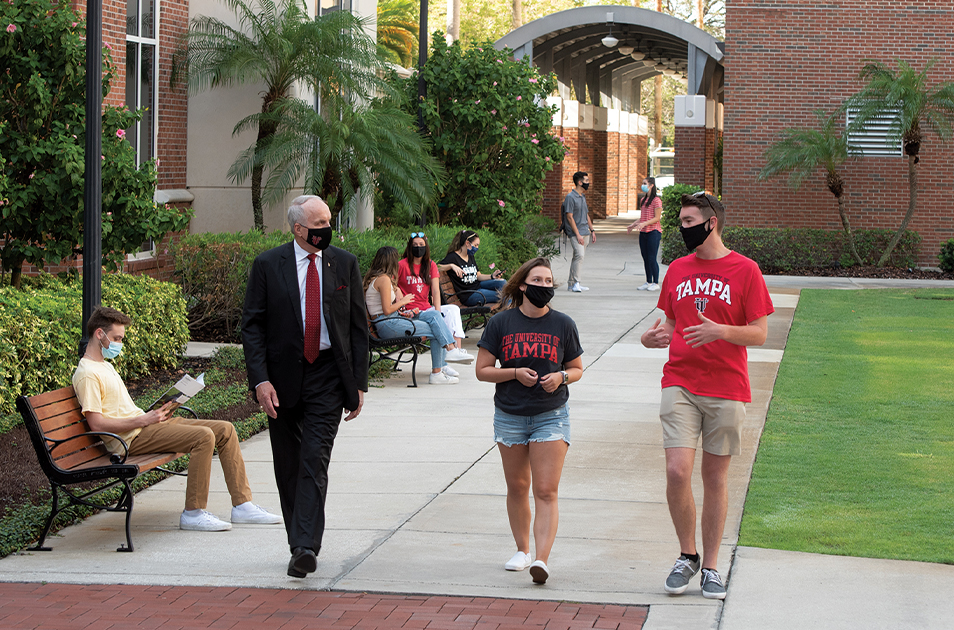 UT adapted quickly to a new learning environment during the pandemic. Photo by Bob Thompson
UT adapted quickly to a new learning environment during the pandemic. Photo by Bob Thompson
You’ve led the University through hurricanes, a pandemic and a recession. Which threat concerned you the most and why?
When we have crises of one sort or another, we pull together and work as a team. Teamwork was never more important than when we had to deal with the pandemic.
In Spring 2020, we had to become an online university in a matter of days due to the COVID-19 pandemic. The good news was that we had recently invested heavily in our school’s technology so we were, in many respects, ahead of the curve when it came to virtual learning technology. We had the technology on our campus to deliver virtual education for our students in a way that we had never done before. We were able to quickly adjust to remote delivery of virtual learning for a short time. In Fall 2020, the University returned to in-person instruction.
Leaders of other universities sometimes call you for advice on how to turn their institutions around. What are some points that are of help to other universities?
The main thing is to focus on improving the student experience. You must make sure you have the best faculty possible, along with a wide variety of designed academic and co-curricular programs, as well as cutting-edge equipment and facilities that best support student learning.
And certainly, there’s a need to move quickly. In our situation in the ’90s, getting buy-in was simple because everyone knew the urgency needed for making changes. Building that consensus can be more difficult when the situation isn’t as dire, but you have to press forward with improvements.
You’ve had great success in fundraising. What have been the keys to your success with donors?
Authenticity is important. I think people respond well to straightforwardness in discussing our vision and how prospective donors can have a positive impact on UT’s future.
A key supporter early in our efforts was John Sykes, our first major donor. In our early conversations, we hit it off well, and his investment in us showed the community that we were moving in a new direction. Others followed him and started to step up.
Over the years, we’ve also seen positive results from our efforts to attract more community leaders and to further develop the Board of Trustees, whose representation now spans the country. Some have taken a leadership role in identifying possible donors. And while many of our supporters are not UT graduates, the alumni who are involved show a passion for what we do that rubs off on others.
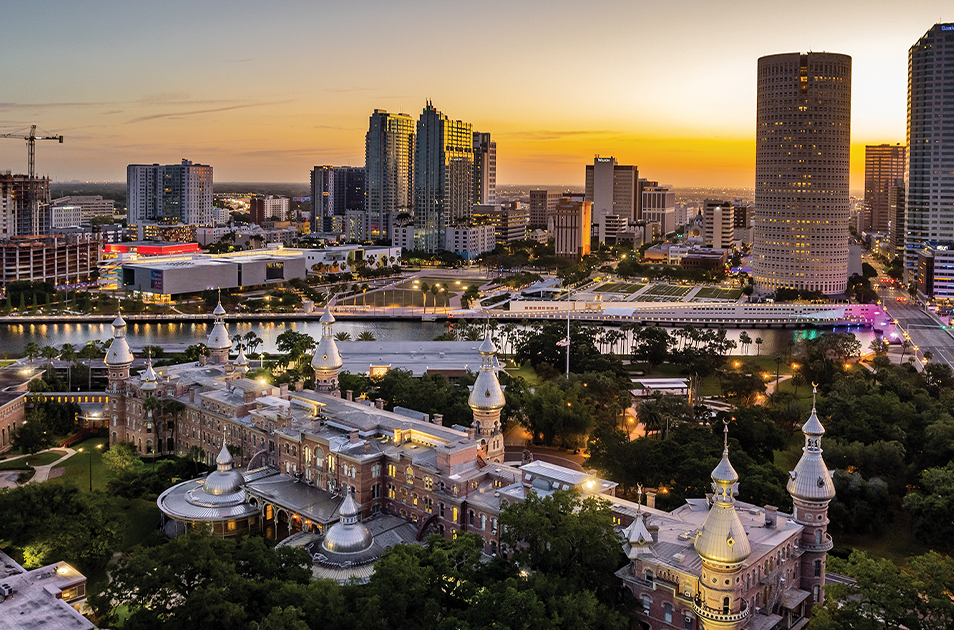 The University of Tampa sits across the river from downtown Tampa. Photo by Marc Vaughn
The University of Tampa sits across the river from downtown Tampa. Photo by Marc Vaughn
How do you think the growth of the University has helped downtown Tampa evolve, and vice versa?
We have a symbiotic relationship with the city of Tampa. Certainly, the University’s growth has been a key factor in downtown evolving, particularly during the 2008 recession, when we were one of the only entities continuing to build.
Being in the heart of one of the nation’s top cities is such a significant part of who we are — it’s a major part of our identity. And now, seeing how downtown has become such a vibrant area, it helps in recruiting our students, who want to be near where the action is.
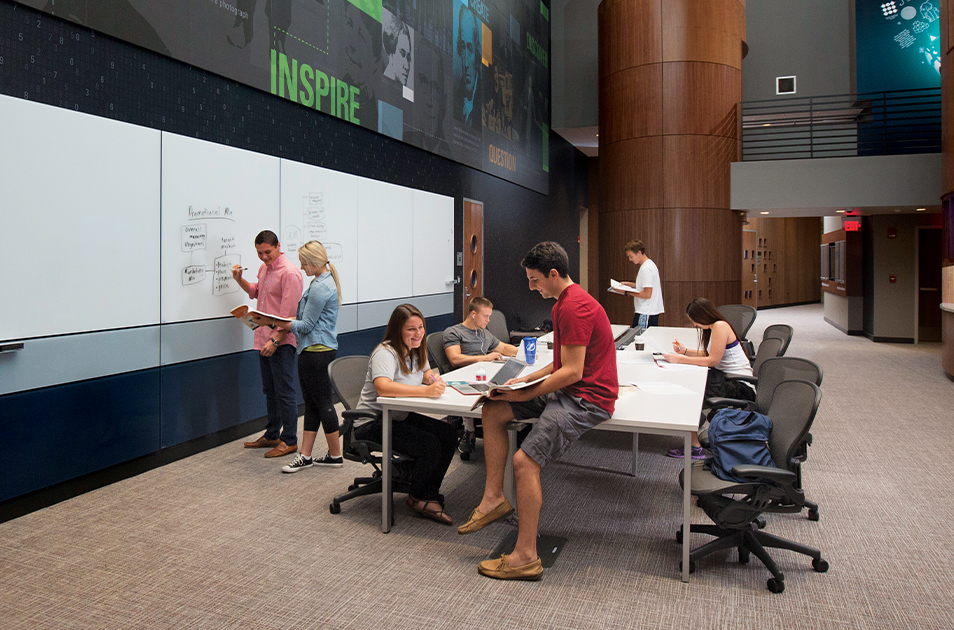 Programs and activities in the Lowth Entrepreneurship Center are an example of UT’s innovative mindset in action. Photo by Andy Terzes
Programs and activities in the Lowth Entrepreneurship Center are an example of UT’s innovative mindset in action. Photo by Andy Terzes
UT’s innovative mindset is evident among the University’s faculty and staff and is key to the student experience. Can you give examples of that mindset in action?
That mindset is definitely a key to our success. It’s critical that our faculty and staff lead the way in everything from experiential learning to undergraduate research to helping our students be what we call “Spartan Ready.”
We want students to be ready for the workforce and for life on their own, to become digitally proficient, prepared to be successful professionals and learn life skills.
We’ve also shown innovation in how we’ve enriched the overall student experience. This is evidenced in the Lowth Entrepreneurship Center; DEI initiatives; programming for veterans; the Sales Institute for Excellence; international and leadership programs; and activities at the Ferman Center for the Arts.
You’ve been an advocate for Spartan athletics over the years. Given all the success, what are your favorite memories?
Certainly, it’s been exciting to watch our athletic teams win conference and national championships. But other statistics I like to reference when I talk about athletics are our athletes’ graduation rates and their GPAs — we truly have scholar-athletes.
I’m happy that about 86% of all our athletes graduate, and we’re aiming for even more. Also, the average of all our 20 teams’ GPAs is 3.3 on a 4.0 scale. Our student-athletes also learn many other lessons by participating in NCAA athletics.
You are exiting at a time when higher education faces no shortage of challenges. What are your thoughts on the current environment?
There is certainly a lot of enrollment pressure on higher education. Unfortunately, due to demographic changes and other challenges, we can expect dozens of smaller institutions to cease to exist in the coming years.
We determined early on that UT needed to be a larger university to offer the greater breadth of academic programs and facilities that today’s students expect. Now, UT ranks among the top 4% of all U.S. independent colleges in student enrollment.
It’s important for The University of Tampa to offer an education that is a better value. We offer value along with a high-quality educational experience. This combination is key to our continued success in attracting and retaining students.
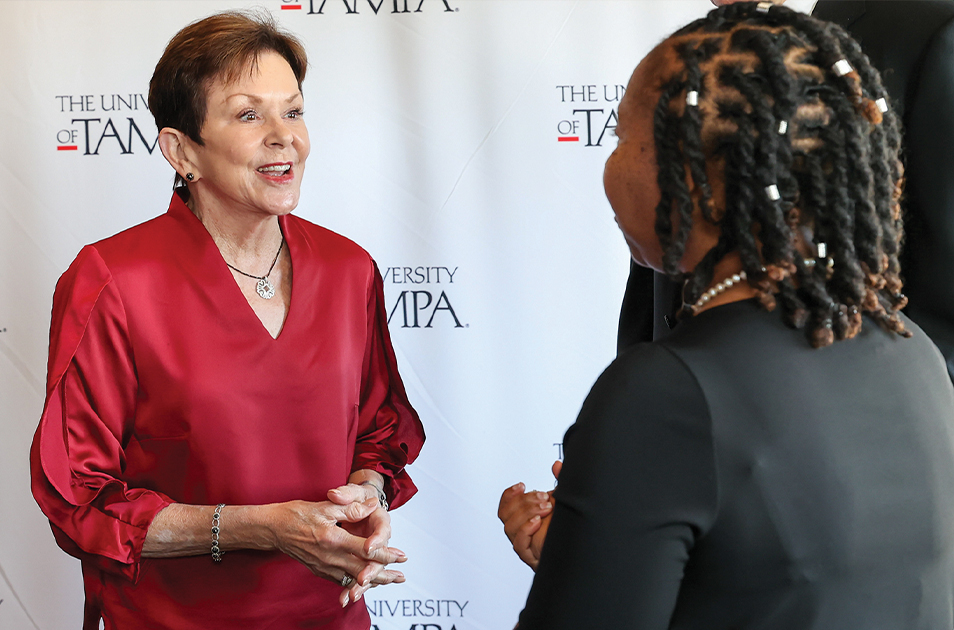 Renée Vaughn has mentored UT students and been a tireless advocate for the University. Photo by Jessica Leigh
Renée Vaughn has mentored UT students and been a tireless advocate for the University. Photo by Jessica Leigh
You and your wife, Renée, seem to never stop, morning to night. How is your energy level so high?
First of all, we love what we do, and we get great energy from interacting with students, faculty, staff and supporters. Renée and I look forward to the many University events we attend, and we see them as a way to hear how the University is doing from everyone’s perspective.
Our days certainly can be nonstop. But it helps that we get a bit of a break in the summers, when the pace is slower, and we can also do some traveling.
What has Renée meant to your work with the University? What do you see as her legacy to UT?
Renée is an excellent partner for our work for the University. She has brought a high level of skill and experience to her role as first lady of UT, along with an extensive network of business and community leaders around the Tampa Bay area.
I see her legacy as helping to build bridges to the community while deepening our relationships within the University. Renée is tireless in her passion for UT and has been an incredible asset to our work. She also has mentored countless students and young alums as they transition to new careers and life challenges.
What do you look forward to after your retirement?
I am looking at ways in which I can help leaders in higher education and business learn from our experiences here at the University. That may take the form of a book or possibly consulting with others to share this knowledge.
Renée and I also will continue some of our many community activities because we care deeply about the Tampa Bay area. And we look forward to finding more time to travel.
You’re an avid fisherman. Are there any fishing destinations that you’re excited to try?
There are many places I still want to go, but, in particular, I am looking forward to taking a trip to Plummer’s Lodge at Great Bear Lake in the Northwest Territories of Canada. The lake is hard to get to, but I’ve heard it’s worth it, with some of the largest lake trout in the world.
Since the lake is near the Arctic Circle, it’s iced-in during the winter, so that would be a good summertime trip.
How would you like to be remembered, if someone talks about your tenure with the University?
I hope that people will remember how we worked hard together and made a difference in transforming UT for the community and future generations.
We have also made a big difference in the quality of UT’s total educational experience. Creating and maintaining UT’s well-rounded student experience has been crucial to our success.
This has been reflected in the growth of our curriculum and educational programs, and despite our dramatic enrollment growth, we’ve always maintained a full-time faculty-to-student ratio of 17 to 1. Over time, we’ve also increased our full-time faculty by almost 400.
Our full-time enrollment is seven times larger than what we had when I started as president, and we’re still growing. With the help of a lot of other people, we’ve not only transformed the educational experience, but we transformed the physical campus with $1 billion of construction. The campus now has 71 state-of-the-art buildings.
We’ve also spent a lot of time planning and designing UT’s future. Despite all we’ve done, there is still much more to do. A new science building, the new Morsani Honors College, an expanded library, and future housing projects are a few examples.
It requires consistent focus, plenty of hard work, and teams of people to strategize, stay a step ahead and execute our plans. Making UT a place where students have a tremendous experience and are ready for the future when they leave us — that’s a key part of my legacy.
